
Lighting the Spark, Feeding the Flame
A Recap of the 2018 IMTAL Global Conference
September 10-12, 2018 at the
Natural History Museum of Los Angeles County
By Douglas Coler, IMTAL President
I was asked by our editor, Ilana Gustafson, to write a recap of Lighting the Spark, Feeding the Flame, our recent 2018 Global Conference in Los Angeles. I was filled with ideas and inspiration from those intensely packed three days. I was there, I opened and closed the conference, I attended all the sessions. How hard could this be? And yet, more than a month after that request, and nearly two months past the end of the conference, I struggled. I have so many notes from those days that to translate them to this forum would prove utterly confusing to our readers, and in the interest of space, I’ve opted for a session by session recap.
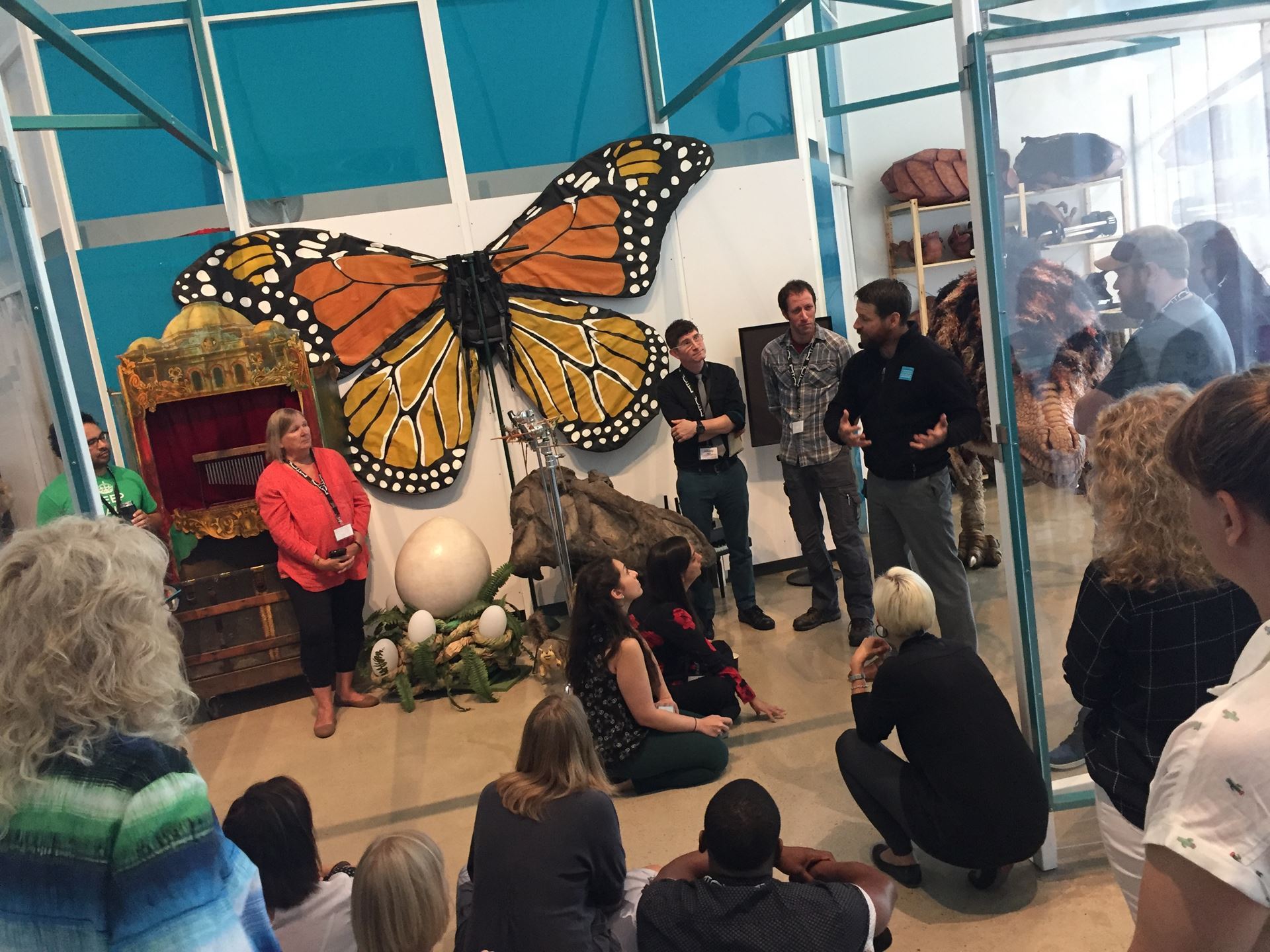 A few folks arrived early enough on Sunday to visit some of the wonderful museums that are situated in Exposition Park and get caught up in the festivities and traffic surrounding the Super Clasico soccer match, happening that very evening in the L.A. Memorial Coliseum (also in Exposition Park), between the two biggest teams in Mexican history, Club America and CD Chivas de Guadalajara. (We pretended the hoopla was for IMTAL returning to the west coast). The Board met at The Natural History Museum, and joined some of our fellow attendees at The Lab Gastropub attached to our home base hotel. After cocktails and tall tales, the evening was still young and some ventured off to explore the city.
A few folks arrived early enough on Sunday to visit some of the wonderful museums that are situated in Exposition Park and get caught up in the festivities and traffic surrounding the Super Clasico soccer match, happening that very evening in the L.A. Memorial Coliseum (also in Exposition Park), between the two biggest teams in Mexican history, Club America and CD Chivas de Guadalajara. (We pretended the hoopla was for IMTAL returning to the west coast). The Board met at The Natural History Museum, and joined some of our fellow attendees at The Lab Gastropub attached to our home base hotel. After cocktails and tall tales, the evening was still young and some ventured off to explore the city.
The next morning, we gathered in the North American Mammal Hall at NHMLA to kick off the conference. We were warmly welcomed by Laurel Robinson, the museum’s Director of Programs. Immediately following, we were treated to a performance of Dinosaur Encounters, presented by Craig Gibson and Jonathan CK Williams, and featuring Brian Meredith in the extraordinarily detailed T. Rex full body puppet. This was followed by a discussion of the program and a visit to get close up and hands on with more of the museum’s collection of puppets and to learn about their operation from the hard working team of performers who bring them to life. There were several times throughout the conference (this was the first) when I think we all would’ve been quite content to have the session go on for several more hours. I certainly felt joy and wonder and a healthy sense of professional jealousy, but this team earned all the institutional support they have. An amazing, dedicated group of artists, to be sure.
 This terrific start was followed by a lively workshop with Brent Blair, PhD, of USC’s Theatre Department. Brent’s session was a callback to those heady times at school/conservatory, when we were all convinced that theatre can save the world. We all knew this going in, of course, but most of us hadn’t experienced the bone-deep truth of that in many years. He followed this with a keynote presentation focusing on his involvement in Liberation Arts and Community Engagement (LACE), “a praxis that employs popular theatre in an interactive method towards the aim of socio- political transformation, popular education, and community healing.” It was, ultimately, much more than even that succinct statement, and painted a powerful picture of the work that is being done, and what yet needs to be done as we develop our programming to fit the new paradigms we’re encountering in our world.
This terrific start was followed by a lively workshop with Brent Blair, PhD, of USC’s Theatre Department. Brent’s session was a callback to those heady times at school/conservatory, when we were all convinced that theatre can save the world. We all knew this going in, of course, but most of us hadn’t experienced the bone-deep truth of that in many years. He followed this with a keynote presentation focusing on his involvement in Liberation Arts and Community Engagement (LACE), “a praxis that employs popular theatre in an interactive method towards the aim of socio- political transformation, popular education, and community healing.” It was, ultimately, much more than even that succinct statement, and painted a powerful picture of the work that is being done, and what yet needs to be done as we develop our programming to fit the new paradigms we’re encountering in our world.
After lunch, Elysia Segal of the New York Transit Museum showed us in A New Train of Thought: Using Technology to Enhance Interactive Storytelling just how far one can go with simple technology and limited budget to engage the digital natives who are, increasingly, our visitors. Elysia’s creativity, joy, and enthusiasm, and her rapping skills, were on full display.
The group was then split for concurrent workshop sessions from Conner Prairie’s Catherine Hughes and Shelsea Ochoa from Denver Museum of Science and Nature. Catherine’s session - Breaking Down the Pieces of Collaborative Museum Theatre - focused on Conner Prairie’s work with Asante Children’s Theatre and their shared desire to expand the collaborative process. A fascinating look at the dedicated hard work of defining and refining what success looks like.
Shelsea’s Cultural Dimensions for Inquiry-Based Learning explored how being
actively open to the cultural perspectives in our communities can lead to a better museum experience for all visitors. Both Shelsea and Catherine presented thoughtful, challenging workshops that gave no easy answers but encouraged continued vigilance and awareness.
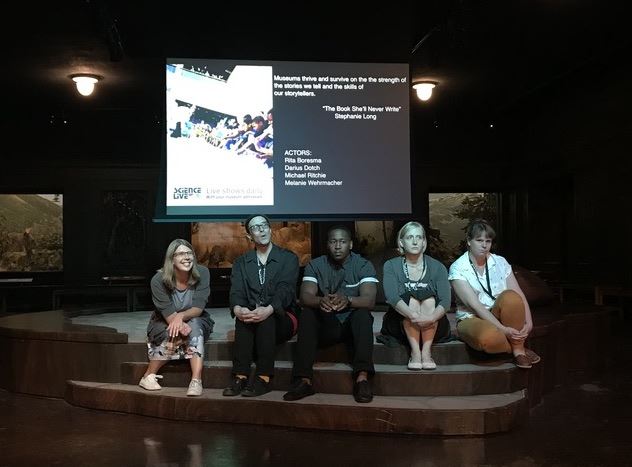 Theatre as the Lab Rat: Exploring Museum Theatre and Theatrical Gaming as a Research Project, presented by Stephanie Long, Darius Dotch, Rita Boersma, Melanie Wermacher, and Michael Ritchie of Science Museum of Minnesota was an in-depth look at how SMM uses museum theatre to support the emerging field of gaming science. It was thrilling, and not a little bit intimidating, to learn about the many script variations, fits and starts, and technical challenges that such programming presents. The SMM team is tight-knit, and they are risk takers. Their audiences are fortunate to share in the creation of their technological, intellectual, and philosophical games.
Theatre as the Lab Rat: Exploring Museum Theatre and Theatrical Gaming as a Research Project, presented by Stephanie Long, Darius Dotch, Rita Boersma, Melanie Wermacher, and Michael Ritchie of Science Museum of Minnesota was an in-depth look at how SMM uses museum theatre to support the emerging field of gaming science. It was thrilling, and not a little bit intimidating, to learn about the many script variations, fits and starts, and technical challenges that such programming presents. The SMM team is tight-knit, and they are risk takers. Their audiences are fortunate to share in the creation of their technological, intellectual, and philosophical games.
As the final session of the day, Aaron Bonds and Johnny Marquis of The Children’s Museum of Indianapolis presented Pushing the Limits: Merging Technology, Special Effects and Creative Writing to Break New Ground in Museum Theatre. Their clear-eyed, practical approach was a reminder that exciting, memorable work starts with clear-eyed, practical planning, and successful programming is an evolutionary process.
The long day ended with an authentic Oaxacan meal at Guelaguetza in the heart of Los Angeles. I’m going to assume that most everyone was as exhausted and excited as I was after day one.
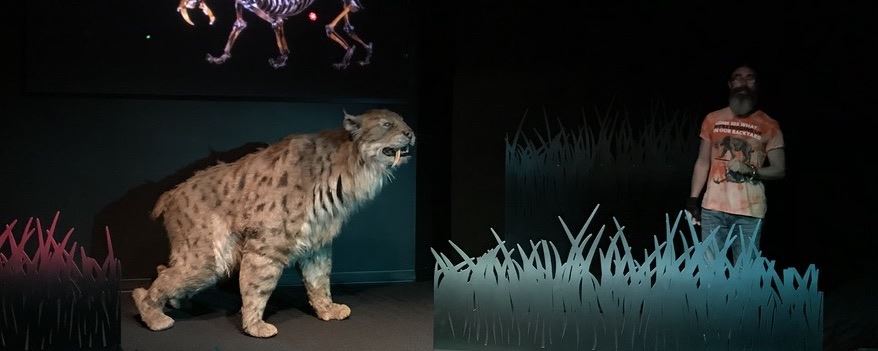
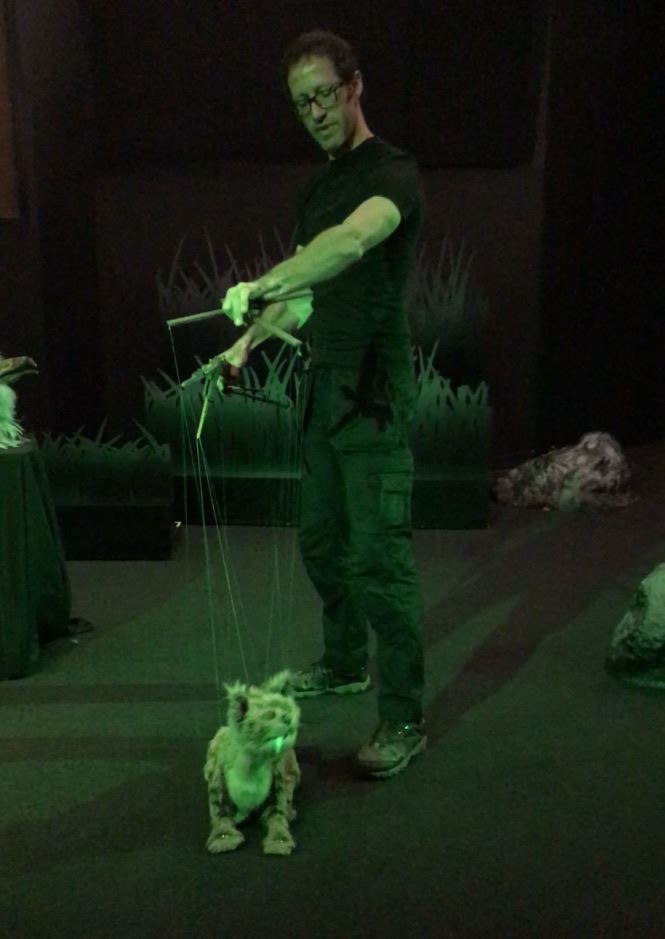
 Day two began with a slight transportation snafu as our journey to the La Brea Tar Pits and Museum was delayed by a wayward bus driver. We arrived later than we’d expected, and yet were still treated to the amazing Ice Age Encounters, again presented by theNHM team in their other home. It’s one thing to know you’re going to see a Saber-toothed Cat puppet. It’s quite another to feel the hairs stand up on your neck when that cat saunters across the stage. These are performers who are at the top of their game. After the show, we were privileged to have Betsy Zajko, Drew McCourt, Eli Presser, Liza McNeely, and Rachael Caselli share the secrets of creating, operating, and performing this magnificent specimen. Eli also shared much more about the puppetry work that this team does, and we got hands on with some of the many creatures they work with. This was another one of those sessions that could’ve gone all day and nobody would’ve complained. Kudos to Ilana Gustafson and her team.
Day two began with a slight transportation snafu as our journey to the La Brea Tar Pits and Museum was delayed by a wayward bus driver. We arrived later than we’d expected, and yet were still treated to the amazing Ice Age Encounters, again presented by theNHM team in their other home. It’s one thing to know you’re going to see a Saber-toothed Cat puppet. It’s quite another to feel the hairs stand up on your neck when that cat saunters across the stage. These are performers who are at the top of their game. After the show, we were privileged to have Betsy Zajko, Drew McCourt, Eli Presser, Liza McNeely, and Rachael Caselli share the secrets of creating, operating, and performing this magnificent specimen. Eli also shared much more about the puppetry work that this team does, and we got hands on with some of the many creatures they work with. This was another one of those sessions that could’ve gone all day and nobody would’ve complained. Kudos to Ilana Gustafson and her team.
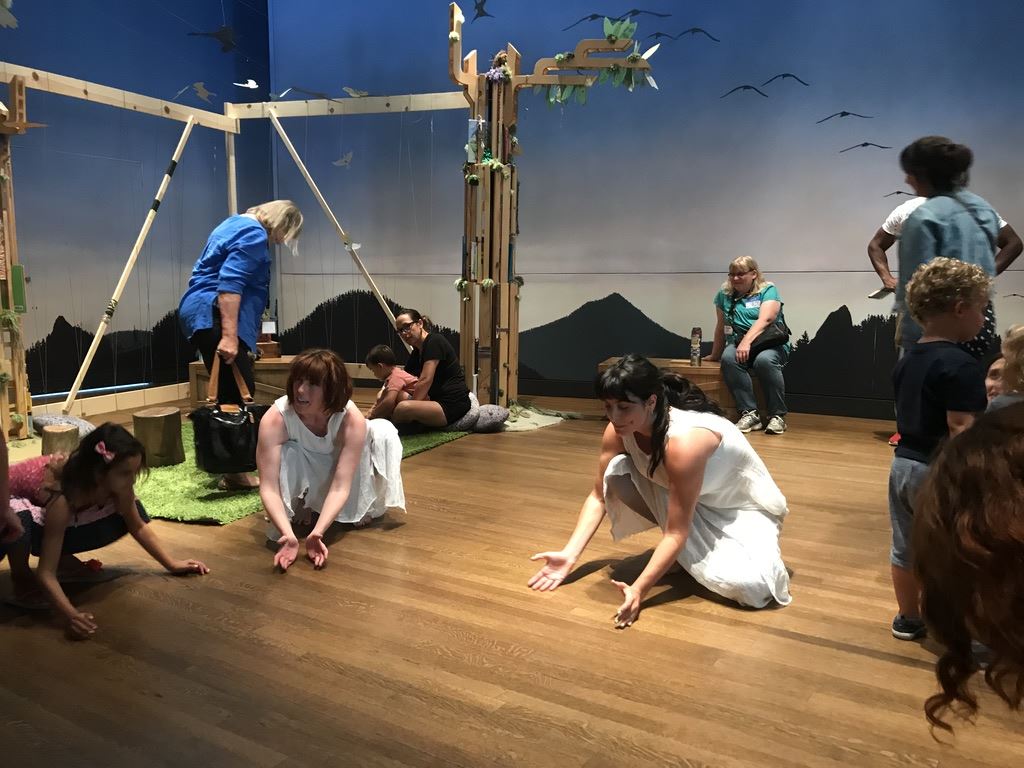 After lunch, the Alleged bus driver delivered us to Bel Air and the Skirball Cultural Center. The permanent installation, Noah’s Ark, is stunning in its innovation and its simplicity. The ark’s animals are created from found objects and everyday items: gears and teapots and ropes and suitcases, umbrellas and bedsheets and mops and kitchen whisks, drums and brooms and marbles. We shared the space with dozens of children who were as enchanted as we were. And then, Belize Wilheim and Julia Garcia Combs
After lunch, the Alleged bus driver delivered us to Bel Air and the Skirball Cultural Center. The permanent installation, Noah’s Ark, is stunning in its innovation and its simplicity. The ark’s animals are created from found objects and everyday items: gears and teapots and ropes and suitcases, umbrellas and bedsheets and mops and kitchen whisks, drums and brooms and marbles. We shared the space with dozens of children who were as enchanted as we were. And then, Belize Wilheim and Julia Garcia Combs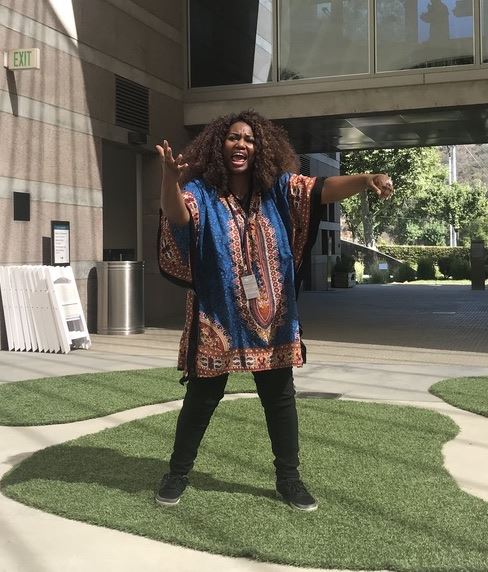 enveloped us in their dance/movement piece, The Whole World is a Narrow Bridge. Deeply moving, intense, joyous, profound, and loving, all woven in around the animals, the ark, and us. After this, we assembled in the beautiful amphitheater and listened as an incredible storyteller treated us to the ancient Nigerian tale of the flood. Group discussion followed, and finally, reluctantly, we put our lives in the hands of our perplexed bus driver for the return to the hotel.
enveloped us in their dance/movement piece, The Whole World is a Narrow Bridge. Deeply moving, intense, joyous, profound, and loving, all woven in around the animals, the ark, and us. After this, we assembled in the beautiful amphitheater and listened as an incredible storyteller treated us to the ancient Nigerian tale of the flood. Group discussion followed, and finally, reluctantly, we put our lives in the hands of our perplexed bus driver for the return to the hotel.
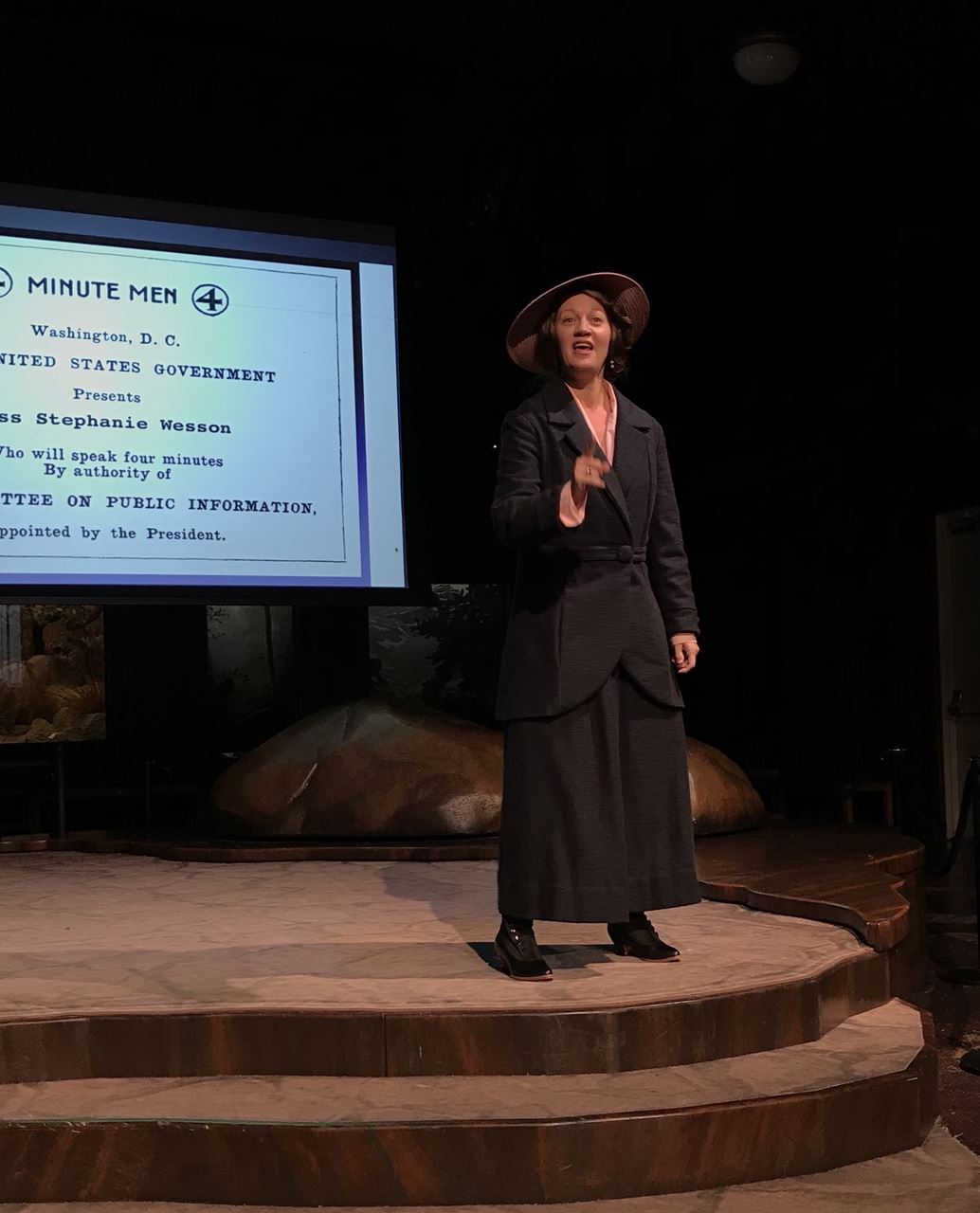 Our final day was once again hosted among the mammals, and began with Keeping the Human in History: Empathy, Costumed Historical Interpretation, & Reaching Underserved Communities, presented by Stephanie Vickers of the University of North Alabama. Stephanie’s program was about WWI volunteers called the Four Minute Men. This was a glimpse into a time in U.S. history that is largely overlooked, and her performance reminded us, yet again, how powerful simple, straightforward costumed interpretation can be.
Our final day was once again hosted among the mammals, and began with Keeping the Human in History: Empathy, Costumed Historical Interpretation, & Reaching Underserved Communities, presented by Stephanie Vickers of the University of North Alabama. Stephanie’s program was about WWI volunteers called the Four Minute Men. This was a glimpse into a time in U.S. history that is largely overlooked, and her performance reminded us, yet again, how powerful simple, straightforward costumed interpretation can be.
We had concurrent sessions again for late morning. Judy Fort Brenneman of Greenfire Creative conducted her workshop Burning, Burning, Burning: The Transformative Power of Story, an interactive session that taught techniques to help “convert chaos to clarity.”
Sue Ellen Winstead of the Littleton Museum presented You Can Do It All (with a little help from your friends), a step by step narrative of how she mounted the first theatrical production her institution had ever done, the lessons she learned, and the pitfalls she encountered.
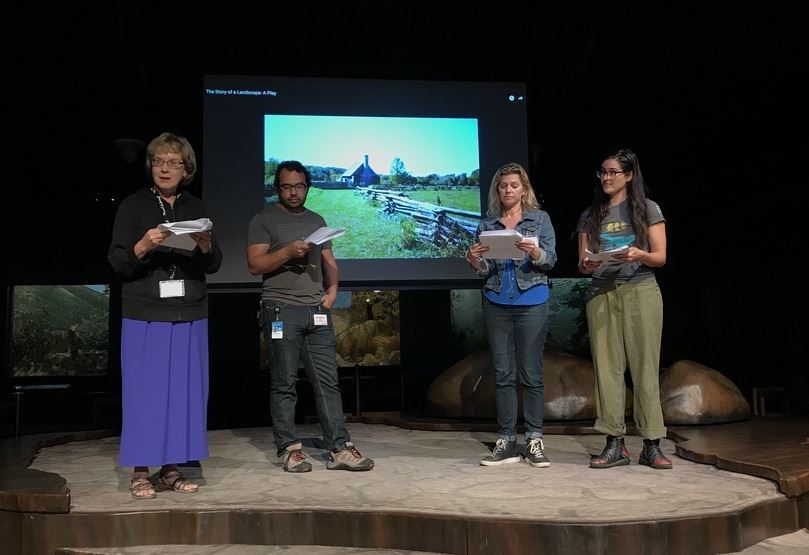
Our final session was presented by Lisa Hayes. Decolonizing Interpretation: Using Theatre to Facilitate Difficult Conversations began with a reading of Lisa’s short play Telling the Story of a Landscape, and transitioned into an examination of The Accoceek Foundation’s National Colonial Farm and their intention to include honest portrayals of the original indigenous occupants of the land, the European settlers on that land, and the enslaved peoples who worked that land. Who’s story is the truth? Who’s story matters? Where do we draw the line, and where does that leave those whose stories are not told? This closing session sparked an amazing, far ranging discussion of the value we place on those stories, the struggle to shine a light on underserved communities, the lives left unexamined in the process, and the responsibility that comes with historical interpretation. The discussion was everything you’d imagine a group of passionate, intelligent people would be like, and it honestly made me proud to be associated with such folks.
The conference was everything we hoped it would be, except for the poor, misguided bus driver. It showed us that we who are IMTAL are still, as ever, a vital part of museum culture, in the U.S. and around the world. It renewed our commitment to education and sharing of ideas, techniques and technologies. The sharing of our weaknesses, of our strengths, our desires, and our fears, and it
reminded us that once the spark is struck, the flame that it creates needs to be
fed. Feed it a regular diet of compassion and hope, daily meals of curiosity and joy. Tend to it, and not only will it keep you warm, that flame will light the way. 
This article can be found in Fall/Winter 2019 - "Holiday Programming (Whether You Like it or Not)" (Volume 29, Issue 1) of IMTAL Insights.